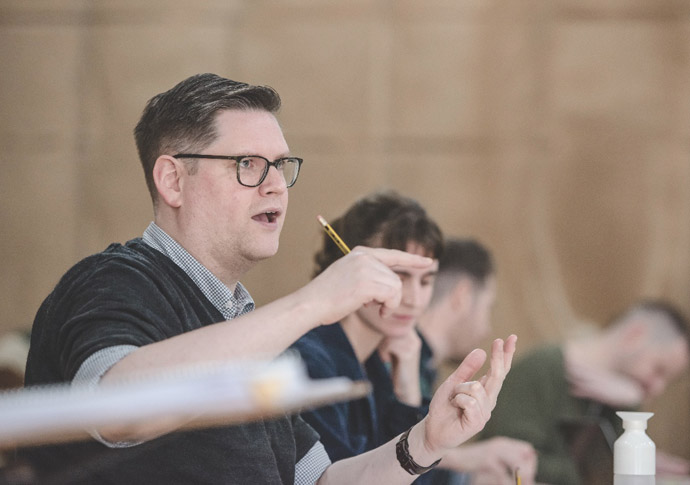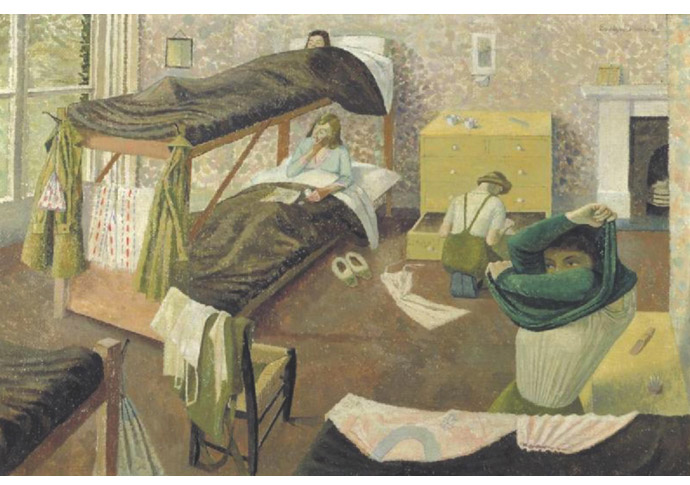Natural selection: war artist who turned her eye to the home front
Evelyn Dunbar’s rural artworks are the inspiration for the ENO production of The Elixir of Love. Dan Carrier talks to its director, Harry Fehr
Thursday, 28th November 2024 — By Dan Carrier

The cast of ENO’s production of Elixir of Love [Marc Brenner]
OUR relationship with the natural world was at the heart of Evelyn Dunbar’s art.
The sole woman to be employed as an official war artist during the Second World War turned her eye to the home front, marking the work of the Women’s Land Army.
She had made her name with her rural images, and when English National Opera director Harry Fehr was seeking inspiration for a new production of The Elixir of Love, Dunbar sprung to mind.
This is the Archway-based director’s debut at the Coliseum: previous work includes at the Scottish National and the Welsh National, in China, San Francisco and Denmark.
And when he began work on The Elixir, he was drawn to Dunbar’s imagery that he first came across as a child.
Harry places the action in rural England, 1943. The war is raging, and a dry-rot smelling stately home is used as a hostel for land girls and a mess for an RAF unit.
We meet Nemorino, a conscientious objector and his love rival Belcore, a dashing RAF commander. Both are seeking the hand of the lady of the manor, Adina.
Poor Nemorino is ridiculed – but then a travelling quack with a suitcase full of tinctures and potions arrives and sells Nemorino a bottle of liquid that he claims will make the lad attractive to all and sundry…
And it is with this setting the director has drawn on Dunbar.
Where other artists captured the evil of the Nazi death camps, or the war’s impact on civilians, she created bucolic images of the shires. Evelyn was inspired by religious beliefs that suggested nurturing the landscape was a way to get close to the creator.
For Harry, there was a personal link: Evelyn was a friend of his grandparents, and painted his mother as a child.

Harry Fehr [Genevieve Girling]
“Evelyn lived in Kent through the 1950s,” he explains. “Her husband, Roger Folley, taught at Wye College where my grandfather was principal, and they became friends. When I was growing up, there were various paintings by her at home and in my grandparents’ house, but the work of hers which I most clearly remember from my childhood was a wooden pelmet which hung over the window in my grandparents’ kitchen. It was bright red and decorated with painted mice – a feature of her more playful work. After my grandparents died, it hung in my dad’s kitchen – but, sadly, after his death it disappeared.”
The original opera dates from 1832 and is set in the Basque country, possibly during the Napoleonic wars. When Harry moved the story to the Second World War, the artist was an inspiration.
“Having decided to set Elixir in a rural community, I researched images from the time, her work depicting agricultural life really spoke to me. Although there are many photos, it’s rarer to find paintings of women working on the land from that time, and they bring a different flavour.
“The colours she used influenced my design team used. I like to think that Evelyn’s work, and, indeed, her position as the only female salaried war artist in the Second World War foregrounds the experience of practical, strong women in a way which this opera does too, through the character of Adina.”
By setting the story in the kitchen and drawing room of a country pile, he found an instantly recognisable “English” backdrop.
“Doing the production for English National Opera, in English, meant there was something delicious about making the whole piece feel very English,” he adds.
“There are archetypes from that period which a modern audience can easily ‘read’, helping them to engage with the story.”

Evelyn Dunbar’s Land Army Girls Go to Bed [IWM]
Making such work relevant to an audience today is a key challenge.
“The starting point for me was: why is Adina not allowing herself to love this man,when, in my mind, it’s clear deep down she does,” he says.
“Part is class and status, but I think there is space for a slightly more complex reason. I liked the idea that she’s caught between two different versions of masculinity, one which is ‘acceptable’, and the other not so. In this production Nemorino is a conscientious objector – someone who is at best considered a coward, and at worst a traitor – while Belcore is an officer in RAF Bomber Command – considered by society to be a brave hero.”
Adina’s character also sits comfortably with the concept of women rolling up their sleeves and doing their bit – just like the Land Army.
“It’s a rare opera which presents a strong female character who is in control of her own destiny – and who doesn’t die,” he adds.
The set-up provides the stage for the comic twists and turns.
“Donizetti knew how to write a tune – and, particularly in his comic works, a very apt tune at that. His music is fun and playful, yet can really touch us. The characters and their motivations are clearly drawn and, if one accepts Nemorino’s gullibility, which is arguably no worse than that of those of us today who spend a fortune on toiletries with a questionable success rate – nothing is ridiculous.”
And while opera has a high-brow reputation, Harry’s brilliant production can be enjoyed by anyone.
“It’s always about clarity: making sure the story, motivations and interactions of the characters are clear,” he says.
“If that clarity is there, then anyone can enjoy it.”
Making opera more accessible is a key aim and by performing translations, the audience can understand the story with no language issues.
“The main barriers to accessibility are perception and cost,” he adds. “Opera is, on one level, a complex art form, involving music, drama, design, and often dance. But it is also a visceral artform. Music has an immediacy which we all understand. And hearing an opera sung in English, as is ENO’s policy, brings a particular level of connection.”
• The Elixir of Love is at the Coliseum Theatre until December 5. See https://www.eno.org